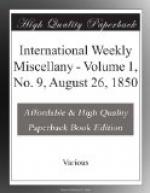* * * * *
An exhibition of indisputable works by the old painters is now open at Valenciennes, in France. It consists of pictures belonging to the family of the Belgian general Rottiers. They are for sale, either single or together. Among them is a St. Denis, bearing his Head, by Rubens, said to have been painted by order of Pope Urban VIII. It was deposited in the Convent of the Annunciades, at Antioch; in 1747, Louis XV. offered 100,000 francs for it, but was refused, the convent having no right to dispose of it. Afterward, on the suppression of the convent, it fell into the hands of the family to which it now belongs. The exhibition also contains a landscape by Salvator Rosa, representing a scene in the Appenines; a Magdalen kneeling in a Cavern, by Kneller; two Allegories, by Giulio Romano; several portraits by Rubens and Van Dyke, besides other works of less value.
* * * * *
Darley’s “Sleepy Hollow.”—The London Art Journal, for July, has the following notice of Mr. Darley’s illustrations of Irving’s “Legends of Sleepy Hollow,” published by the American Art Union: “The charmingly quaint original legend told with so much quiet humor by Washington Irving, is here illustrated by a native artist in a congenial spirit, and his scenes realized in a manner which must give its author satisfaction, and redound to the credit of the designer. We have before noticed the great ability exhibited by Mr. Darley for the mode of illustration he adopts, which we may add is that rendered famous by Retzsh. The series we are now noticing are quite as meritorious as that designed by the same artist to Rip Van Winkle; but the subject matter is not equally capable of such broad contrasts in drollery as that legend presents. Nevertheless, Mr. Darley has executed his task in the truest appreciation of his author; and his hero is the veritable Ichabod Crane of Irving; his love-making scene with “the peerless daughter of Van Tassel” is exquisite in its quiet humor; so also is the merry-making in the Dutch Farmer’s home. Altogether, the series is extremely good, and does the greatest credit to the designer. American literature thus illustrated by American artists cannot fail to achieve honor to that country in the old world as well as the new. We believe Mr. Darley, in his line, to be as great as any American artist whose works have fallen under our notice.”
* * * * *
Chaucer’s Monument.—The Athenaeum says, “One of the objections formerly urged against taking steps to restore the perishing memorial of the Father of English Poetry in Poet’s Corner was, that it was not really his tomb, but a monument erected to do honor to his memory a century and a half after his death. An examination, however, of the tomb itself, by competent authorities, has proved this objection to be unfounded—inasmuch as there can exist no doubt, we hear, from the difference




